|
|
Muay Thai
a system of unarmed combat, Muay Thai (or Thai Boxing) originated in what is now Thailand over two thousand years ago. Its precise beginnings are shrouded in legend, but early records show that monks trained novices to become bodyguards for the royal family. Exhibition fights were frequently staged for the royal court, and they could be brutal. Fighters had their hands wrapped with rope, which was coated with a sticky resin and then dipped into crushed glass. The bouts often ended in death. Thankfully, Muay Thai has evolved over the centuries. Competitors now wear protective equipment as they try to score with punches, elbows, knees, and kicks. Rugged and spectacular, Muay Thai is the national sport of Thailand. It is also enjoying a surge of international popularity with practitioners is countries such as in England, the Netherlands, Belgium, France, Australia, Brazil, the United States, and Canada. Muay Thai differs from Karate, Tae Kwon Do, and Kung Fu in several respects; Kicks and punches are delivered with full power and without holding back. Even today, boxers fight barefoot, wearing only cotton anklets on their feet and boxing gloves on their hands. Patterns, or so-called "Katas", do not exist in Thai Boxing. Focus, power, timing, and reflexes are developed by constant sparring practice, hitting the kicking and punching bags and pads, and participating in matches. Muay Thai is primarily a pugilist (boxing) system, which uses basic, but powerful kicks, punches, knee and elbow strikes. Practitioners of other martial disciplines because of its devastating effect revere the Thai swing kick (roundhouse). When aimed at an opponents lower region (rib cage, thigh, or knee) the target area often becomes numb which may cause the recipient to drop to the ground immediately due to the pain. Along with that, add punishing elbow and knee strikes that are commonplace in the Muay Thai arsenal and this system becomes an almost unstoppable weapon for the stand up fighter in the ring or in the street.
Thailand has a proud fighting
heritage. All year round, the stadium throughout the Kingdom are
packed with fans who gather to cheer on their boxing heroes. The
Thai boxer uses his fists, elbow, knees and feet as the weapons of
attack. Muay Thai is fought over five frantic three-minute rounds
with two minute breaks. While knockouts do occur, most bouts go
the distance. For these, two judges and the referee award points
for effective strikes. Before each fight begins, both boxers
perform a graceful pre-fight dance of deep spiritual significance known
as the Ram Muay.
For a Thai boxer, the pre-fight Buddhist rituals are as important as the
fight itself. The rituals are the soft balance to the hard
elements of ring warfare. A calm well of inner strength of fight
skill and fury that overflows into the ring. For the Muay Thai
fighter, the pre-fight dance, know as the Ram Muay, is the traditional
method of focusing on the spirit, in order to understand all it's
strengths and limitations. The dance rituals are most important as
they are a living performance of beliefs and the state of the spirit.
It begins when the monkhon is place on the fighter's head before he
enters the ring. The monkhon is an elaborate stiff headband - made
of hemp - that extends down the back between the shoulder blades and end
in the silk thread tassel.
The monkhon is a sacred object which has been blessed by
seven Buddhist monasteries. It is not the property of the boxer.
Instead it belong to the teacher and his training camp. Placing of
the monkhon on the fighter's head reminds him that he represents not
just himself and family but also his teacher and the camp for which he
fights. Many believe that the monkhon is blessed with magic spells
to ward off injuries and evil spirits. The monkhon is not worn
during the fight. But Thai boxers often wear a piece of cloth
around one biceps called the kruang rang with powers believed to have
emanated from spiritual charms, amulets, herbs and spells.
A kruang rang is given to the fight during the temple
ceremony that he goes through, before being accepted into his chosen
training camp. It is blessed by the monks and becomes a fighter's
talisman. No fighter wears a kruang rang for dress purposes.
Rather it is an object of deep spiritual belief.
The fighter enters the ring with his
monkhon and begins to walk counter clockwise around the ring, sealing it
against forces of evil. For the fighter, it means that a psychic
barrier is raised around the ring through which no one's desire for him
to lose can penetrate, thus ensuring that one fighting spirit can fight
another fighting spirit without hindrance.
The
wai kru begins with the boxer kneeling in the centre of the ring facing
towards his training comp. Gloves are brought together in a
traditional manner clasped at face height. The boxer then wais
(bows) three times. Each wai pays homage at several levels-as with
all pre-fight rituals. The fighter bows in respect to the Buddha (
a man, not a god, who attained enlightenment through the complete
understanding of the human mind nature), the Sangha (the order of
monks who are seeking enlightenment) and the Dharma (the Buddha's
teachings). At the same time he also pay homage to his teacher,
training camp and his fighting ancestors. It is for the fighters
an intense moment of focus, a form of meditation that sends him inward
to the clam well of the fight fury. The Ram Muay dance follows.
It is a beautiful, graceful slow dance which moves in each of the four
directions, seeking protection from each.
The four-fold movement also expresses the fighter's belief in the four
noble truths of Buddhism which remains him that the world is dukkha
(impermanent and unsatisfying). The four virtues of compassion,
temperance, prudence and justice are expressed and balance the hard form
of deadly Muay Thai. The gloves then circle the air above the
kneeled fighter's head, symbolically paying homage to the higher powers
and asking for courage and protection in the battle ahead.
Each camp has a distinct and different Ram
Muay. While performing the Ram Muay, the Thai boxer centres
himself. His body awareness is total and shown by the control of
his dance movements and the sense of power that emanates from a forceful
but well controlled performance. Moving inward to basic body and
power awareness, the fighter is able to focus the body in the dance and
be warned of his physical limitations. At the same time he is put
in touch with his capabilities. Rarely does one fighter watch
another's dance. Instead, they prefer to meet spirit to spirit
without prior knowledge gained by any close scrutiny of an opponents
pre-fight dance.
Muay Thai traditions date back to the days when the skills in hand to
hand combat were a survival necessity. Thailand has a culture
linked to the battlefield and these combative skills can seen with the
rituals and fighting fury in the Muay Thai ring. The rules of Muay
Thai have changed over the years. A century ago Muay Thai was fought
until only one of the fighters remained standing. Each combatant
had his hands wrapped in a covering cloth and in old times, the glued
and glass.
Muay Thai contests followed the way of western boxing with the
introduction of a ring but it was only after World War II that the rules
of Muay Thai were finalized in today's form. Thailand's sporting
authorities decided to standard the rules of Muay Thai to make it
acceptable world-wide and to establish recognized professional
standards. It was decided that a Muay Thai contest would be
divided into five-three minute rounds with two minute breaks.
Declaration of fouls is intended to ensure the fighters use the weapons
of Muay Thai unheeded i.e. the use of fists, elbows, knees, shins and
feet as well as fascinating, clean grappling. One referee and two
judges keep a ten point scoring system and make the fifth round.
An even round is judged 10-10, slight advantage 10-9, wide advantage
10-8 and one side10-7.
Ø
Hitting an opponent who is down or rising after being down or after the
end of a round.
Ø Wrestling or roughing at the ropes.
Ø Butting with the head.
Ø Poking or thumbing the eye.
Ø Pulling the hair.
Ø Fighting while holding the rope.
Ø Cunningly avoiding an opponent's
attacks, such as by feigning to fall or slip
under the rope, or hiding behind the referee.
Ø Intentionally kicking or kneeing the
groin.
Ø Any unsporting action causing injury to
an opponent.
The use of foul blows results in a penalty of one point. The
winner is declared from a decision on points, knockout, technical
knockout, an opponent surrenders, or a fighter is dismissed from the
ring due to a serious foul. The referee also has the power to
declare a no contest if he considers the fighters to be not genuine in
their endeavors. This way the referee can stop any sham contest.
|
The
8 Weapons Of Muay Thai
|
It's the weapons that make the difference and in Muay Thai the
combatants are free to use the body's most powerful weapons to their
best advantage. A Thai fighter refers to the two feet, two fists,
two elbows and two knees as the eight weapons. When combined
together, these eight weapons are a dangerous combination. The
feet are used for long distance body contact, the knees and fists for
medium range attacks, while the elbow is used exclusively as a short
rage weapons. An experienced Thai fighter has sound defensive
techniques for protection against the eight weapons. One effective
measure often used as a counter manoeuvre in ring combat, is know as
"the wall of defence", whereby the fighter protects himself by
rising a knee to make contact with a lowered elbow to form a protective
shell. This human shell has the strength to absorb the attacking
thrusts emanating from any of the eight weapons. Whether they be
short, medium or long range, any of the eight weapons, if executed
correctly, can strike an opponent with lightning speed and precision
accuracy.
When
it comes to strength in the ring, grappling is the big test.
Unlike western boxing where the clinch is illegal, Muay Thai allows the
fighters to grapple for position and ascendancy. When two boxers
cling to each other in combat they use their knees, fists and elbow to
attack their opponent. Grappling is strenuous work and requires a
great deal of conditioning to hang onto an opponent who has defensive
techniques that can keep an opponents clinch without making any
attacking moves, the referee will separate the two combatants as
grappling without action is not permitted in a Muay Thai contest.
Wall of
Defence
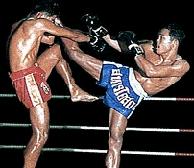 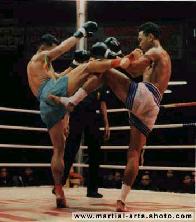
| With
a wall of elbows, forearms and defensive knees, the Muay Thai
'wall of defence' is regarded as an impregnable shield. In fact,
so strong is this defence that Muay Thai rules state that both
boxers must maintain aggression throughout all five rounds.
Thai fighters are
trained to defend against all forms of attack. Defensive moves
are precise and can be switched into attacks at any moment.
Breaking through the Muay Thai defensive wall is difficult but
possible. Knee rams and roundhouse kick are key weapons for
breaking down the wall.
|
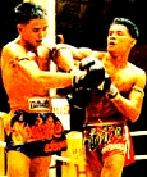
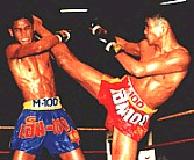
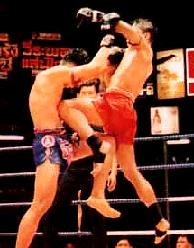
As
Muay Thai is a close combat sport; skillful grappling and knee
techniques are required. A tough close-quarters fighter can be
extremely effective in taking the wind and the will to fight, out of an
opponent. A knockout move is almost certain when an opponent's
head is brought down to an upward-driving knee.

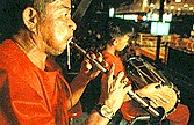
In Muay Thai bouts, the abilities of power
punching is also demonstrated but doesn't score high points. It's
the elbow strike that singes out the Thai Boxer from the other martial
artists. An elbow attack strikes its is the weapon used for a fast
knock out.
A
big difference between international western boxing and Muay Thai, is
that the judges will award the decision to fighter consider to have
proven himself the "ringmaster" after five rounds. Point
are not determined by the number of strikes but rather by the number of
effective blows. Of prime importance is the effectiveness of the
strike, its strength, the target and, most importantly, how the much
disadvantage it causes the opponent. Among other, lesser aspects
which impress the judges -and they are definitely taken into consider
action during scoring - are the defensive abilities of the two
contestants.
At the end of contest it's the judge's task to identify who is the
"ringmaster". The over- riding question to be determined
by the judgement is : which fighter dominate the contest? Thus the
final fifth round is often the decider.

|
|








